Mainland Australia · Tasmania · New Zealand · Fiji · USA · Canada
This account of my journey home from Vanuatu follows on from my 2001 travel diary, and is adapted from the various e-mails that I sent home...
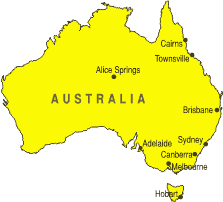
January 2002
Sydney
My friend Janice and I arrived in Sydney to find the city ringed by bush fires and the sky dark with smoke. It is summer here and sweltering hot, although the heat is dry and the nights are cooler, which makes a refreshing change from Vanuatu.
Janice has relatives in Sydney, who were extremely kind and welcoming to both of us. We stayed with Janice's great aunt in Canley Vale, a suburban area west of the city. Although Canley Vale is a long way from the city centre, it isn't right on the outskirts and it is therefore in no danger from bush fires. We went into the city centre on New Year's Eve, and found a spot on the forecourt outside the Sydney opera house from which to watch the midnight fireworks. They were spectacular, with rockets exploding continuously overhead and showers of sparks pouring off the Sydney Harbour Bridge.
Port Macquarie
From Sydney we got the bus northwards, stopping first in Port Macquarie, which wasn't the most exciting of places. We left it too late to get accommodation in town and ended up at a youth hostel out in the bush on the far side of a river, which had to be crossed by a rope ferry. The hostel was nice, however, and I saw plenty of Australian wildlife on long evening walks - kangaroos, kookaburras, galahs (there are flocks of these everywhere), cockatiels, pelicans, and a beautiful multicoloured parrot. There were also dolphins in the river.
Coffs Harbour
We spent the next two days in Coffs Harbour, a slightly-more interesting seaside resort that is famous for its "Big Banana". This is a working banana plantation that has been turned into a bizarre banana-related theme park with various rides, shops selling every banana product imaginable and tours of the plantation. The centrepiece of the place was, of course, a colossal model banana.
While in Coffs Harbour we also went to the "Pet Porpoise Pool", and watched a show with seals balancing balls, dolphins jumping through hoops, and an Australian sea lion that had been trained to go into the audience and 'kiss' everybody. I got a peck on the cheek from the whiskery creature, then, in its enthusiasm to do the same thing to Janice (who was sitting next to me), the great thing climbed right on top of me. It was like a big, flippery, blubbery dog.
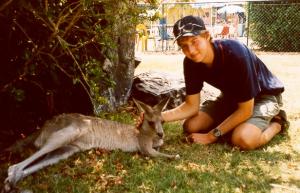
Meeting some Australian wildlife in a park at Coffs Harbour
Byron Bay
The next stop on our journey northwards was Byron Bay, which is WEIRD. It's a tiny town but the place is jam packed with thousands of young people, surfers, hippies, party animals, and freaky drugged-up people. The streets are lined with bizarre shops selling every kind of natural, organic, rastafarian, vegan, and herbal food ever invented.
The Gold Coast
Surfers Paradise, on Queensland's Gold Coast, is one of the most commercialized and hypertouristed places I've ever been to, with mile upon mile of high rise buildings and resorts running along a concrete coast. Janice and I spent a day at Dreamworld - Australia's version of Disneyland. I must have changed a lot whilst in Vanuatu, since I went on a lot of evil rides that I wouldn't usually go near, including the Cyclone ("the biggest gravity rollercoaster in the southern hemisphere"), and The Big Drop (on which they winch you about a hundred metres into the sky and let you admire the view for a few seconds before dropping you in freefall).
Queensland: think of Florida and you've more-or-less got the picture. It even has the same slogan - "The Sunshine State". The only difference is that it's upside down, with the hot, swampy peninsula in the north and the more developed part in the south. The climate here is much like Florida's, too - it's summer and very hot, although we're not yet back in the tropics (where the Wet Season is in full swing and the weather forecasts look pretty unpleasant).
Culturally, Australia is very Americanized. The number of McDonalds outlets - "Maccas", as the Australians call them - is unbelievable. Beer gardens, liquor stores and gambling clubs full of "pokies" are also everywhere. There are also lots of big shopping malls, in which we've spent a lot of time, partly because they're air conditioned and partly because the Western choice and affluence is still overwhelming after Vanuatu.
Brisbane
Janice and I spent the next few days in Brisbane, which is a big place (the third largest city in Australia, after Sydney and Melbourne), yet is one of the most attractive cities I've seen. The city centre is luxuriously clean, open, spacious and modern. We visited numerous botanic gardens and parklands, which are totally unlike the drab parks that you find in temperate cities such as London and New York. The gardens in Brisbane are spacious and elegantly decorated, and as the climate is subtropical, they are full of palm trees and other exotic species that would be houseplants back home. The City Botanic Gardens on the riverside include, amongst other things, a sizeable mangrove swamp (accessed by a wooden walkway) right in the heart of the city. In the evening we walked across the river to the parklands in the city's South Bank - one of the most beautiful urban locations I've ever seen. There is a huge flower-covered archway, a free open-air swimming pool with artificial beach and palm trees along the side, bright and colourful lighting, attractively-landscaped walkways, fountains (the whole of Brisbane is full of interesting water features) and the lights of the city shining across the water.
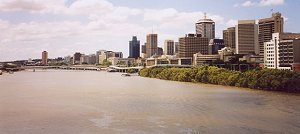
Brisbane
The Sunshine Coast
North of Brisbane, we visited the town of Noosa, and spent a day on a bus full of Melburnians touring the attractions of Queensland's "Sunshine Coast". The first stop was a working ginger factory. This was followed by a visit to the "Big Pineapple" - a pineapple-plantation-turned-theme-park that is dominated by the colossalfibre-glass pineapple at the entrance. (Australia is full of kitschy "big things": we've also seen the Big Banana, the Big Prawn and the Big Cow.)
In the afternoon we went to Australia Zoo, the one run by insane TV crocodile hunter Steve Irwin. The croc feeding demonstration was informative but not terribly impressive (the man himself wasn't there, of course), although watching a keeper trying to prevent a large and determined wombat from joining in with the excavation work being carried out in its enclosure was hilarious. At one point we got a fright after wandering down a narrow, overgrown path and being met by an agitated keeper who told us: "Turn back - she's got young, she's very aggressive and she'll attack anybody". Fortunately the creature she was talking about turned out to be a small duck! The shop at the zoo sells, amongst other things, ridiculous dolls of Steve and Terri Irwin that talk when you squeeze them.
The weather remained fantastic - blue skies and hot winds that made us feel as though we were standing beside a giant hair drier. At night we swam under the stars in the river at Noosa, which was pleasantly warm even though it was late in the evening. In the distance we could see tens of thousands of giant bats emerging from a cave somewhere for the night's hunting. (Brisbane was full of enormous fruit bats too - under the streetlights they could be seen dangling from the trees.)
Hervey Bay
Having a day to spare in Hervey Bay, we decided on the spur of the moment to go skydiving. We travelled to the airport, got a ten minute training session, then piled into a tiny plane smaller than a car, which somehow managed to hold six people (me, Janice, the two tandem partners with whom we were skydiving, the pilot and a cameraman). It took forty minutes for the plane to climb to the desired height of 14,000 feet (4300m), during which time we got spectacular views across Hervey Bay, Fraser Island and the Great Sandy Strait in between. I wasn't completely terrified, but it was definitely unnerving to sit in the plane for so long slowly watching the world getting smaller and the needle on the altimeter rising inexorably. At the end we were so high that we were passing around an oxygen mask from which to breathe.
When door of the plane was opened, the rush of air outside was intense. With the instructor strapped to my back, and the parachute strapped to him, I worked my feet out awkwardly of the door and put them on the step outside. When the instructor tapped me on the shoulder, I let go. I'm not sure exactly what I let go of, but a second later I was rushing downwards at a hundred miles per hour. It didn't feel like jumping and falling - we accelerated blindingly fast in the thin air, and all I could feel was the incredible force of the wind rushing by. We plummeted in free fall for sixty seconds before the chute opened (with a painful jolt) and suddenly the rush of air was gone - we were dangling almost silently over the bay. The instructor handed me the parachute ropes and showed me how to turn us left and right by yanking on them - it was an amazing thrill, although quite dizzying. We landed at some speed on the beach, and I touched down with a thud on my backside. The next we did a day safari of Fraser Island, which is one of the great natural wonders of the world. The island is essentially a gigantic sand bar - the world's longest, at around 80 miles (130 km) in length - yet it supports rainforests and a huge variety of wildlife, all thriving on pure sand. We were taken around the island in a special 4 wheel drive bus; all the roads are made of sand and even this bus managed to get bogged down on a couple of occasions. The vast sandy beach on the eastern side of the island - Seventy Five Mile Beach - is both a designated highway, full of 4WD vehicles, and an airfield used by the many small planes that take tourists over the island. We saw two of Fraser Island's notorious dingos as our tour bus made its way along the beach.
We were taken to see huge, desolate 'sand blows', the rusting carcass of a stranded ship (built in Scotland), and a idyllic sandy-bottomed creek trickling through the forest, in which we swam. We also visited a huge, round, glassy lake high in the sandy forest, in which the water was warm and slightly acidic, so that it turned my hair soft and fuzzy.
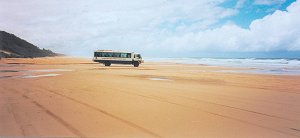
The tour bus on the beach at Fraser Island
My old sandals finally gave up and broke as we were trekking around the island. They've been brilliant, though, when you consider what I've put them through - I swam in them regularly in Vanuatu then baked them in the tropical sun afterwards to dry them out, I've trekked across mountains in them, been for 20-mile walks in them, skydived in them, jumped into waterfalls and off bridges in them, battered cockroaches with them, ridden a pony in them, played games in them, and basically lived in them for five months.
Unfortunately the weather had taken a turn for the worse. There were showers all day, and heavy rain that night. Storm drains that were dry when we arrived in Hervey Bay were metre-deep the next morning.
Bundaberg
Back on the mainland, we visited Bundaberg, a small sugar-growing town famous for its rum. (According to one story, the 'unique flavour' of Bundaberg rum comes from the giant cane toads that get crushed up in the sugar-harvesting machinery.) In the morning we went on a tour of the distillery, had a large sample of the product, and walked shakily back into town.
That night we stayed up until 3 a.m. watching nesting and hatching turtles at the nearby Mon Repos beach - the largest turtle rookery in mainland Australia. Because it is such a good place to see turtles, Mon Repos understandably attracts large numbers of visitors, who are first taken to a visitor centre and are then divided into small groups who take their turn to go down to the beach, guided by rangers, and observe the turtles. Great care has to be taken not to cause too much disturbance to them as they come ashore to nest. That night there was a particularly large crowd of visitors because 26th January was Australia Day - a national holiday.
On our first trip down to the beach we saw nothing but an empty nest - the hatchlings had all disappeared by the time we arrived. However, the second occasion was more exciting. We watched a huge female loggerhead turtle lumbering back to the sea in the moonlight, after laying her clutch of eggs, then saw a whole group of tiny hatchlings from an earlier nest scuttling towards the sea. One of the researchers who was there picked one up for us to touch. Its little flipper pushed against my finger with surprising strength.
Rockhampton
The next day we crossed the Tropic of Capricorn again, and arrived in Rockhampton. Unfortunately it was a public holiday (because the previous Saturday was Australia Day) and almost nothing was open. We went into the tourist information centre and were told that the only thing open was the botanic gardens, a couple of miles out of town. Since no public transport was running, the guy in the information centre gave us a lift up there in his car.
Mackay
After travelling north through another 200 miles of absolute nothingness - except for gum trees and cattle ranches - we came to Mackay. The countryside around here is actually quite attractive - we can see the mountains of the Great Dividing Range in the distance - but there's an lot of it and it all looks much the same.
We tried to escape from the scorching heat by going up into the mountains, to Finch Hatton Gorge on the edge of the rainforested Eungella National Park. We didn't succeed in getting away from the heat, but we did get to try 'forest flying', which involves gliding through the rainforest canopy in a harness dangling from a steel cable. At one point we passed a colony of roosting fruit bats. The forest flying scheme was set up by a friendly Yorkshire couple who have emigrated to Australia and got back to nature in a big way, living in a self-built, semi-underground hut surrounded by 74 acres of mango trees and pristine rainforest. We were the only visitors that afternoon, and before doing the forest flying, we were invited to sit by the creek and eat fresh homegrown mangoes. Afterwards we went for a walk through the national park to a nearby waterfall. It was a nice walk, and we're assured that the metre-long snake that Janice nearly trod on wasn't a dangerous species.
February
Airlie Beach and the Whitsundays
Our next stop was Airlie Beach, "gateway to the Whitsunday islands". The place looked stunning - the sky was blue, the sea was blue (although sadly too full of deadly box jellyfish to go swimming in) and we could see small islands silhouetted in the distance. It made a welcome change from the sprawling sugar-growing towns of the past few days. Although these places are not big in terms of population, they are designed with the assumption that everyone has a car, and are so spread-out that walking around them takes hours, which isn't much fun in the melting tropical heat.
From Airlie Beach we got a boat to Hamilton Island, one of the Whitsunday Islands. The Whitsundays are beautiful, but not in the way that I had imagined. I'd pictured them as flat, sandy, palm-fringed cayes, yet in fact they are rugged, mountainous and forested.
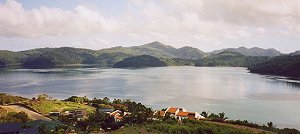
The Whitsunday Islands
Hamilton Island is a couple of miles (3 km) long and rises steeply out of the Pacific. It has a proper road network, but rather than using cars most people buzz about the island on tiny petrol-powered golf buggies. We hired one of the buggies and had a fantastic day exploring the island's various attractions. We had a game of crazy golf, and then tried 'wire flying' - launching ourselves off the hilltop on a full-size hang-glider suspended from a steel cable, which is great because you don't have to worry about steering or control. After a delicious pizza for lunch at a nice waterfront restaurant (we got a free lunch voucher when we booked the ferry), we went target shooting at the rifle range, at the suggestion of Janice. She was scarily good at it (despite coming from Northern Ireland, where gun-related sports are not exactly encouraged), and hit the bullseye several times. Having never used a gun before, I failed to hit the bullseye, but nineteen of my twenty bullets were at least within a few centimetres of it. The other one managed - remarkably - to sever one of the strings supporting the paper target. We finished the day off with a swim in the pool at the island's resort.
As if we hadn't had enough excitement, back in Airlie Beach we spotted a special offer for parasailing together with jet ski hire. The parasailing was good but tame compared with skydiving. The jet skis, however, provided a real adrenaline rush. We were on a two-person one and Janice drove first, roaring across the waves at over 60 kmph (40 mph) with me desperately hanging on behind.
Townsville
We spent the next two days in Townsville, one of the biggest cities in tropical Australia - although this facts says more about how underpopulated tropical Australia is than about how big Townsville is. Townsville has a reasonably attractive harbour, and is surrounded by stark rocky mountains that come right up to the city. However, it's not the most exciting of places, and the climate is digusting - not only is it hot, but the humidity is stifling. When we arrived, a thunderstorm was raging over the nearby mountains. In these conditions sweat pours off you the whole time, and even the nights are dripping hot (this time we had the misfortune to get a hostel room without air-conditioning).
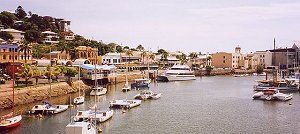
Townsville
From Townsville we got the ferry to 'Magnetic Island' - which is not actually magnetic, although Captain Cook believed that it was because his compass malfunctioned as he sailed past. It's quite a beautiful place - dry, rocky, mountainous and covered with pine trees, almost like Scotland (although Scotland could never be this hot). We got a bus tour round the island, stopping for afternoon tea at the 'Magnetic Mango' plantation (the mangoes were no more magnetic than the island, of course, but the local mango jam was delicious with scones). We also went to some lovely secluded beaches. It would have been nice to escape from the heat by going for a swim, but the sea is completely out of bounds at this time of year because of the box jellyfish.
Cairns
A six-hour bus journey to Cairns formed the last leg of our journey north. Cairns is a nice place - there's plenty to do, the scenery is pleasant, and the city centre is small enough to wander about on foot. It was still hot (34°C/93°F) and quite humid, but with cool sea breezes the climate wasn't as unbearable as in Townsville.
With great difficulty, Janice persuaded me to get on a horse, and we went for a trail ride through the bush near Cairns. (I wasn't keen on the idea of horse riding after having fallen off Janice's cousin's pony back in Sydney - most of Janice's Australian relatives witnessed the incident and it took them a long time to stop laughing.) This time, however, the ride was quite relaxing - the horses walked gently all the way, which suited me just fine (although it frustrated Janice, who wanted to go galloping off into the wilderness). We rode uphill to a lookout from which we could see out to the reef islands, and stare down at a luxury home supposedly belonging to Elton John. Back at the stables I had a go at trying to crack a whip, but merely ended up whipping myself in the face (fortunately I was wearing sunglasses to protect my eyes).
The next morning we went white-water rafting, which was exhilirating fun. In one of the more violent rapids the guide deliberately got the raft stuck in a rapid, so that we could have a go at 'surfing', which meant clinging on desperately while water poured at us from all directions, throwing ourselves continously from right to left to prevent the raft from tipping over. One guy actually fell out, but the guides had anticipated this and one was waiting downstream with a rope. At a couple of the safer rapids we got out and swam down the river. The water was luxuriously warm, and by this point we were soaked anyway.
In the afternoon, we tried out the 'Minjin' - essentially a 40 metre (120 ft) long swing, which dangles from the bottom of the AJ Hackett bungee tower on a scenic rainforested hillside overlooking Cairns. Janice and I were strapped into a hang-gliding harness, in tandem, and hoisted up backwards until we were at almost the height of the tower. We then pulled a cord to let ourselves go. There followed the nasty sensation of simply being dropped. It was far more frightening than either of us expected. By the time we had reached the bottom of our swing we were doing over 70 miles per hour (110 km/h). We swung back and forth for a long time until we lost momentum, and were then released.
From Cairns we went diving on the Great Barrier Reef, off a small boat with about thirty other divers and snorkellers on board. The first site at which we stopped had an immense variety of colourful corals and fish, including huge batfish (like stripy butterfly fish but about the size of a large baking tray) that swam right up to us. There were also enormous giant clams, just like in cartoons, colourful and over a metre (3 ft) long; they snapped shut with an eerie thud when provoked. On three occasions we came across big sea turtles grazing on the reef - they were very tame and allowed us to swim right alongside them.
The second dive was at a set of "bommies" - tall patches of reef rising steeply out of the ocean. The fish here were even more prolific than at the previous site, although disappointingly the harmless resident shark wasn't around. On the edges of the bommies were red, feathery gorgonian sea fans and other bizarre corals.
The next day we visited the village of Kuranda in the mountains above Cairns, which we reached via a 5 mile (8 km) long cable car that glides over spectacular rainforest. In Kuranda we visited a fruit bat hospital, where the girl on duty (another Brit on a gap year) was like an assistant in a clothes store as she showed us each type of fruit bat in turn. She would say something like "oh, I'll just get you a brown one for you to look at", unhook the sleepy creature from its perch on the ceiling and carry it upside down to see us. The bats were very tame (apparently they are intelligent and get used to humans very quickly) and surprisinglycute, with bodies were about the size of rabbits' and inquisitive, cat-like faces.
That evening in Cairns there was a spectacular tropical storm, with lightning illuminating the sky like a disco.
Alice Springs
At 1 a.m. we embarked on the 34-hour coach journey south-west to Alice Springs. First we travelled back down the coast to Townsville, then headed inland into the Queensland Outback. The landscape through which we passed was flat and arid, densely vegetated in some places but little more than yellow grassland in others. It was incredibly empty, and apart from some cows and a solitary emu it was fairly lifeless. As we headed towards the centre of the continent the terrain became hillier, and patches of red rock and earth began to poke through the vegetation. There were also thousands of small red termite mounds sticking up above the spiky grass. We had dinner at Mount Isa, an outback town dominated by the chimneys of its huge mining operations, then continued through the night into the Northern Territory. We changed coaches at Tennant Creek, where the road westwards from Queensland meets the north-south road through the middle of the country, and headed south towards Alice Springs. By 6 am we were about halfway between Tennant Creek and Alice Springs, right in the middle of nowhere, and it was at this point that our coach broke down. We spent an hour or so in a weird little country inn, reminiscent of something out of Crocodile Dundee, whilst the coach was repaired.
In Alice Springs the sun was roasting, but the climate was far more bearable than on the coast, because it wasn't oppressively humid. The adjective that best sums up the place is "dry": the town is surrounded by an arid landscape (not totally barren desert, but not very green either) and the Todd River, which flows through the town, is just an empty strip of sand. Alice Springs itself is flat but there are steep outcrops of red rock nearby. Though small, Alice Springs is the biggest place for a thousand miles in any direction, and even in town you get a real sense of being in the Outback.
For various reasons, on all of the next five days we were up at or before 4.30 a.m.. This left us exhausted, but gave us the opportunity to see some glorious Outback sunrises.
The morning after arriving in Alice Springs, we went hot air ballooning over the desert at dawn. Ballooning is a strange experience; it doesn't feel like flying at all. There's no rush of air or sudden movement, and no sensation of rising or falling. We climbed to 6000 ft (2000 m), saw Alice Springs and the nearby Macdonnell Ranges from the air, and got a real sense of just how empty this country is. The landing was less serene than the rest of the flight - vertically we came down very slowly, but horizontally we were travelling at quite a speed and it was unnverving to see the long grasses rushing past as we approached. When we finally hit the ground, the basket tipped at a 45 degree angle and almost fell over.
Later that day we hired bikes and rode south along the dry Todd River, visiting a date plantation and a camel farm.
Alice Springs has a very strong Aboriginal community and one morning we went on an 'Aboriginal discovery tour'. This began with a nature walk, during which we saw hare wallabies, a bearded lizard, some interesting birds, and several plants that the Aborigines use for medicine or food. On the way we passed the historic telegraph station around which Alice Springs was founded, and the springs (named after an early telegraph engineer's wife) that gave the town its name. We tried 'desert raisins' (strongly flavoured with a weird aftertaste), 'desert passion fruit', and 'desert orange' (a delicious fruit that tastes like blended tropical fruit drinks). We also had a go at throwing a boomerang, watched (and joined in with) some traditional dancing, and learned about local Aboriginal traditions.
The Red Centre
From Alice Springs we embarked upon a two-day adventure tour that took us on a round trip totalling 900 miles (1400 km), in which we saw no evidence of human habitation whatsoever except for the occasional service station or cattle ranch. (One of these cattle farming properties was, we were told, the size of Northern Ireland.)
First we visited Kings Canyon, an immense gorge surrounded by fantastic rock formations. We climbed up to one rim of the canyon, then descended some steep wooden steps to the cool and well-vegetated 'Garden of Eden' below. Everywhere was red rock. In some places the rock was layered like stacks of paper; in other places it was like walking over a natural paved street.
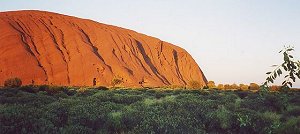
Sunrise on Uluru
We camped for the night at Yulara, a few miles from Uluru (Ayers Rock). The little tourist complex at Yulara, built exclusively to accommodate those visiting the Rock and other desert attractions, is in fact the fifth largest settlement in the whole Northern Territory (Uluru is one of the few tourist attractions in the world with its own major airport). Our permanent campsite was well equipped - in fact, it was better than many of the proper buildings in which I stayed in Vanuatu - and from a nearby dune we watched the sunset over Uluru. From a distance, the huge red monolith, which is the biggest single lump of rock in the world, doesn't appear real - it's like staring at a watercolour. We had tents at the campsite but choose to sleep outside under the stars, which of course shone brilliantly. It is said that you can see more stars from central Australia than from anywhere else in the world.
We woke at 4 a.m. the next morning to watch the sunrise on Uluru, then walked around the base of the rock. Close up, its size is breathtaking - it stands over 300 metres (1000 ft) tall and is covered in interesting patterns, many of which have great spiritual significance to the local Aboriginals. I had the opportunity to climb the Rock, but didn't, partly because I wanted to walk around the base instead and partly because climbing Uluru is strongly against indigenous beliefs.
From Uluru we moved on to the Olgas - enormous rounded mountains rising mysteriously out of the flat desert. (It's politically correct to use the Aboriginal name, Kata Tjuta, nowadays, but 'Olgas' sounds so much nicer.) Here we hiked up a spectacular red valley in between two of the giant humps.
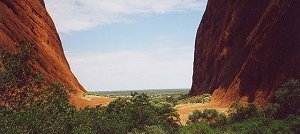
Olga Valley
Although this area is supposed to be red desert, much of the countryside we've passed through is surprisingly verdant and full of grasses and bushes - more like savannah than desert. Apparently the reason for this is that for the last two years the area has had an unprecedented amount of rain - Alice Springs' annual rainfall has increased from a meagre few inches a year to a figure comparable with that of south-eastern England. As a result, the desert has bloomed in a serious way. Nobody, including the local Aboriginals, has ever seen anything like it. People blame climate change.
Adelaide
We continued southwards to Adelaide. The exhausting 20-hour journey was really just one long, open road stretching for nearly a thousand miles through empty desert - quite amazing if a little monotonous. The only interesting place we passed was the opal mining area of Coober Pedy, where the flat ground is littered for tens of miles with heaps of pale mining refuse like giant anthills.
Near Adelaide, we took a day tour of the Barossa Valley, one of Australia's most famous wine-growing regions. The area resembles parts of France, with European-like fields and rolling hills, dotted with chateaus and small villages - all very unlike the thousands of miles of scrublands and gum forests that comprise the rest of Australia. In one afternoon we visited four wineries and sampled a total of 32 whites, reds, ports, meads and liqueurs.

The Barossa Valley wine-growing region near Adelaide
On the way bak to Adelaide we tried out the 'Whispering Wall', a dam whose curvature transmits sound across the valley eerily well - I was able to stand on one side and have a conversation with Janice 140 metres (460 ft) away on the other side without even raising my voice.
As we were walking down street in Adelaide that evening, we spotted a small bar with the words "Kava Hut" written on it. We went in and, sure enough, it was a real kava bar - serving kava imported from Pentecost! I had a 'regular' shell, which was small, watery and had no noticeable effect, althogh it does come in more potent strengths.
Melbourne
Another long bus journey took us to Melbourne, which is very much a big city, unlike Adelaide, which has the feel of an overgrown country town. Melbourne is not a totally awful place, but suffice it to say that Neighbours does a good job of portraying the nicer parts of the city while neglecting to show some of the grottier areas (for instance, the miles of refineries that you pass on the way into the city). With buildings that are old-fashioned by Australian standards, and trams clattering up and down the stone streets, the place has quite a European feel. In the evening it is chilly (I'm wearing trousers for the first time in months), and there is an autumnal feel in the air.
A Janice's suggestion, we went on a Neighbours tour, a pilgrimage for fans of the saccharine Australian soap. All of the men on the tour were either gay or had been dragged along by their wives or girlfriends or girl friends, and it was a thoroughly embarrassing experience. First we wandered about "Ramsay Street" (not the street's real name, of course), which was remarkably tiny - they must use a very wide-angle lens when filming the show. In real life, houses such as "number 28" and "number 30" have numbers such as 3 and 5. The tour group had lunch whilst loitering outside the TV studios, but didn't catch a glimpse of anyone famous. We then went back into the city via the school that they film at, which is actually an English language school for foreign kids. The suburb in which Ramsay Street is located looks different from the way in which it is portrayed on TV - in real life it is steeply hilly, small and crowded, multicultural, and quite run down in places.
In the afternoon we went to the huge new Melbourne Museum. Architecturally the place is impressive - more like an airport terminal than a museum - and some of the content is good, but there isn't really enough there to fill the vast building. Of course, the first thing Janice wanted to see when she got there was a Neighbours set and accompanying exhibition. In real life the sets - all fake and wooden, of course - are painted in very dull shades because the filming method makes colours look much brighter on screen. The Melbourne Museum also contained a rather explicit human body gallery - so explicit, in fact, that they gave us a printed warning about it in twelve languages as we entered the museum.
Canberra
After nine more hours of dull, yellow Victorian countryside, we arrived in Canberra, the Australian capital, which was the one place I'd been to so far on this trip that was almost exactly how I'd imagined it. The city is green and spacious, it was hot and sunny and the skies were blue - a nice change from Melbourne. The entire city - including the lake at its centre - is completely modern and artificially planned (it reminded me a lot of Milton Keynes, the English 'new town' near which I grew up), but it is set in pleasant countryside surrounded by mountains. Instead of skyscrapers, the skyline is dominated by the giant Captain Cook Memorial Water Jet that shoots out of the lake. We walked on the huge grassy roof of Parliament House, which is designed so that it is basically part of the hilltop on which it stands. The place is massive and gives a real sense of power. It is a bit too immense and imposing in a way - the colossal, bunker-like construction is reminiscent of something the Nazis might have built.
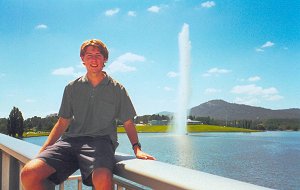
In Canberra, in front of the Captain Cook Memorial water jet
After Canberra, Janice and I returned to Sydney. There we explored The Rocks - the historic, convict-built area of the city, which started life as an overcrowded slum but is now an attractive place with lots of narrow little alleys and trendy shops and cafés. Later we climbed the famous Harbour Bridge, and looked down on Sydney from 134 metres (440 ft), giving us a fantastic view right across the entire city. However, more amazing than the view was the bridge itself - the size of it is mind-blowing. The safety aspects of the bridge climb is taken very seriously: climbers are given grey suits (to avoid distracting passing traffic), breathalysed, and put you through a metal detector to check that they aren't carrying any loose objects before being let onto the bridge. The climbers themselves are in little danger, however, since they are clipped to a safety wire all the way up and there are always handrails to hold them in.
The next day Janice's aunt took us up into the picturesque Blue Mountains, where we rode the world's steepest railway - a dizzying 52-degree incline. The bush fires around Sydney were long gone, but a terrible storm a few days earlier had done a fair bit of damage.
At Sydney airport I bid farewell to Janice and flew to Hobart, Tasmania.
I fell in love with Tasmania almost as soon as I stepped out of the airport. The island is like a new and improved version of Scotland. The city of Hobart is situated next to a picturesque inlet at the mouth of the Derwent River, surrounded by high mountains and dark green forests. Being jammed between the mountains and the sea, the place doesn't sprawl in the way that most Australian cities do, and in some ways it feels more like a little fishing port than a state capital. The climate is chilly, compared with the rest of Australia, but during the day it was almost warm enough to go outside in a T-shirt.
I hired a bike and cycled to the Cadbury Chocolate Factory, a historic building situated on a beautiful peninsula in the river estuary, a few miles north of the city centre. The tour was far more thorough than the one at Cadbury's World in England, allowing visitors to see almost all of the stages of the chocolate-making process close up. In places I could have reached out and dipped my hand in vats of warm melted chocolate if I'd been allowed - obviously I wasn't, but I did get handed plenty of legitimate samples along the way. The chocolate mixing areas are kept at 37°C (99°F) to keep the chocolate liquid, so the factory made a nice change from the chilly weather outside. The cocoa smell pervading the factory was wonderful. We tried Cadbury's latest product, released two weeks ago - a Dairy Milk bar with soft chocolate mousse trapped inside each of the squares - and saw a range of other sweets being made, including strawberry creams and fudge. (A far greater variety of Cadbury's products is available in Australia than in Britain.)
I also visited the small Tasmanian Whisky Distillery in the centre of Hobart. Among the samples I was offered was a mercifully small volume of their "Old Hobart", with 60% alcohol.
I next spent three days doing a "wild and west" adventure tour of Tasmania's rugged west coast, which is unbelievably similar to the Scottish Highlands. Unfortunately, as well as the same scenery it has the same vicious and unpredictable weather. On the first day I was shivering in a thick fleece and a padded raincoat; I've never known anywhere to be so cold in summer. Later it was wet. It didn't seem like rain, or mist, or low cloud - just water hanging magically in the air and soaking everything, not to mention completely spoiling the views.
From Hobart the tour set out to Mount Field National Park, where we explored a patch of lush temperate rainforest. There were tree ferns, and colossal swamp gums - the world's largest flowering plant. This rainforest is a remnant of the vast primeval forests that stretched right across Australia and Antarctica during the days of the dinosaurs when the southern continents were joined. Over millions of years, mainland Australia moved north and dried out, while Antarctica moved south and froze, but in Tasmania fragments of the ancient forest survive. We were shown trees whose fossil remains have been found in Antarctica. Once upon a time this area was home to the thylacine, the dog-like 'Tasmanian tiger' that has come to be a symbol of the island's unspoilt wilderness (which is ironic, since the creature was systematically exterminated by European settlers). Now the park is inhabited mainly by pademelons - cute miniature wallabies that look and act like big bunnies.
From there we travelled to Lake St Clair - Australia's deepest lake, high in the mountains. We then moved westwards through the vast uninhabited area of south-western Tasmania that has been designated a protected World Heritage area because of its unique wilderness. We stopped for short walks in a few places, but most of the scenery was shrouded in cloud. At one stop, we made our way across a fast-flowing river on a shaky steel rope bridge that was only safe for one person at a time (and, even with one person, felt very unstable). In some places there were mountains, in some places there were dense forests, and in some places there were boggy flatlands inhabited only by button grass. The brown dyes released by this button grass stain all the rivers the colour of cola.
Upon leaving the wilderness area we descended into a steep valley that was utterly bare and barren - the result of copper mining and the acid rain that occurred when the copper was smelted. After a while the forests returned and we arrived at the place where we would be spending the nigh: a group of chalets in a picturesque location next to a wooded lake surrounded by mountains. There we were pleased to find a log fire to relax and warm up beside, with live music playing.
The next day the weather was clearer and I went down to the lake at dawn, where I caught glimpses of two duck-billed platypus fishing in the water. After breakfast we headed down the west coast, and visited the huge expanse of Ocean Beach. Here, the full force of the Roaring Forties blowing across the Southern Ocean slams into Tasmania's sandy coast with some spectacular white swell. Someone sailing due westwards from here would go two-thirds of the way around the world to Argentina before hitting land. To the south there was nothing between us and Antarctica.
Near to Ocean Beach is a vast area of sand dunes, interspersed with dark pine forest. I spent three-quarters of an hour rocketing around these dunes on a quad bike, which went extremely fast and slid perilously in the sand, making it difficult to control. The fact that it was essentially a four-wheeled motorbike, and I've never ridden a motorbike, didn't help. I was also bounced up and down a lot as the bike rode over the dunes. In one place our guide led the party of quad bikes right over a cliff in the sand dunes, and we nervously followed him over. I was surprised to find myself still upright at the bottom.
In the afternoon we returned to Tullah and embarked on a steep hour-and-a-half climb up nearby Mount Farrell. The views from the top were spectacular, but it was a hard and steep climb. I cut my leg on a rock, and also returned to find that my ankle was also soaked in blood - the work of a leech that had attached itself to me and then got accidentally squashed. We saw some berries that looked like purple, foil-wrapped Cadbury's mini eggs, and also saw blackberries growing (a strange sight in March). Back down at the lake we went canoeing, which was a very peaceful and relaxing experience - drifting amidst the silent forest.
The next day we visited the national park surrounding Tasmania's famous jagged Cradle Mountain. To view Cradle Mountain we first had to climb to Marion's Lookout, which was itself a substantial mountain. It took us an hour and a half to ascend, and much of this time was spent climbing steep wooden steps that wound their way up the rock faces. The view from the top was breathtaking - we could not only see Cradle Mountain, but could look out all the way across northwestern Tasmania, right down to the sea. We could see forests, mountains, lakes, and deep glacier-carved valleys - but apart from the car park we had come from, there was absolutely no sign of human habitation anywhere. It was total wilderness.
As we were about to leave in the tour bus, we spotted something big and brown ambling down the grassy hillside. It was a wombat. We followed it through the boggy grassland, and it allowed us to get quite close to it, continuing to munch away at the plants as if we weren't there. It was the size of a small dog, with a face like a koala's and a body built like a bear's. As we made our way towards the wombat, we disturbed a huge wallaby, which bounded past us.
In the afternoon we headed for the town Launceston, via Sheffield (the "town of murals") and Devonport (a harbour town on the north coast). The countryside here in northern Tasmania is more English than Scottish, and consists mainly of rolling farmland. Among the apple orchards, sheep pastures and potato fields, there are some ominous-looking enclousures surrounded by barbed, electrified fences and big red 'Keep Out' signs. These are used to grow another of Tasmania's major crops - opium poppies for the pharmaceutical industry.
Summer in northern Tasmania is like summer back in Buckinghamshire - golden fields, fresh fruit, blue skies and sunshine, and little old-fashioned towns and villages. Raspberries and blackberries are both in season, and I took full advantage of this chance to get lovely fresh summer fruit at an unusual time of year.
I went on an afternoon bus trip around the Tamar Valley, which runs north from Launceston to the sea. I stopped at a unique seahorse farm, where tens of thousands of the animals are bred for aquarium pets and Chinese love potions. I was shown round different tanks, each one crammed with hundreds of seahorses, ranging in size from tiny babies like little mosquito larvae to huge ones the size of my hand. The bus tour also took me to a winery, and to Grindelwald - an unusual but pretty 'Swiss village' in which all the buildings are built in Alpine style.
Launceston itself is a pretty, old-fashioned looking town (Australia's third oldest), with a European feel to it. In the early evening I walked around Cataract Gorge, the scenic chasm that runs almost into the centre of the town.
After Tasmania I flew to Wellington in New Zealand. Wellington is a pleasant city, built around an attractive harbour area adorned with numerous quays, terraces, bridges and sculptures. I spent a longafternoon in the huge, impressive, and completely free national museum. The weather on the day I arrived was beautiful and sunny; the next day was a bit grey but at least it wasn't too cold. However, Wellington deserves its reputation as the "windy city".
On Saturday morning I headed inland through North Island to Rotorua. First the bus passed through low green farmland full of sheep, then rolling green hills full of sheep, then steep green hills full of sheep, then green mountains full of sheep. This was followed an utterly barren area with nothing except flat plains of yellow grass and purple heather.
Rotorua is surrounded by pine forests, lakes, and dormant volcanoes. It is a sprawling, modern tourist town, built around a vast American-style main street that you could comfortably land a jet aircraft on if it weren't for the strip of greenery down the middle. (Rotorua's main street supposedly has the longest continuous stretch of motels in the world.)
However, the interesting thing about the town, and the main reason that all the tourists come, is that the Earth's crust is very thin here, making Rotorua one of the most geothermally active places in the world. In various parklands around the town, steam pours out of holes in the ground and wells up mysteriously from behind bushes. Many houses feature what appear to be smoking chimneys, which are in fact venting volcanic vapour from the ground below. The town's golf course gently steams like a hot pudding. The backpacker hostel I'm staying in, like most places in town, has its own geothermally-heated spa bath in the back garden. The downside to all of this is the fact that the eggy stench of sulphur is everywhere. Last night I could barely sleep because of the smell.
I toured the area's attractions on a shuttle bus, driven by a crazy Maori guy. First we went to the Boiling Mud Pools - the name more-or-less sums up the place. Then we visited the Wai-o-tapu park, which isn't like an ordinary park: here the lakes boil, the streams are scalding hot and give off steam, the waterfalls drip yellow with sulphur, the ponds are stained by minerals in unnatural-looking colours, and a choking mist hangs over much of the landscape. The centrepiece of the park is the famous Champagne Pool, so called because the water in it gently fizzes and boils. However, the really striking thing about the pool is its colour - bright orange around the sides and a deep mineral blue in the centre. Unfortunately I couldn't stand next to the pool for too long before the acrid mist coming off it started to burn my throat. It was amazing to think that life on earth probably started in a pond like this. We also saw the Devils Ink Pots (black gurgling pools), and the Devils Bath (a small lake whose water was coloured an unbelievable shade of fluorescent yellow-green).
At 10.15 a.m. we watched the daily 'performance' of the Lady Knox Geyser. This begins with a park ranger chucking a bag of soap down the geyser's steaming vent. After a few minutes soap suds start pouring out, and this soon builds up into a full eruption, with boiling water shooting into the air. It was still spurting like a demented fountain when we left, half an hour later.
With all the tourists who come to Rotorua there is a huge (and surprisingly inexpensive) variety of extreme activities on offer here. This afternoon I tried out the unique New Zealand sport of 'zorbing' - rolling down a hill inside a translucent plastic ball, like a giant hamster. As it was a hot afternoon I went for the "washing machine" option, in which they chuck a bucket of water in there with you. Fortunately the ball was well padded and the experience wasn't as bad as I'd expected. After the zorbing I had a quick ride on New Zealand's fastest jet boat, screaming from 0 to 60 miles per hour (100 km/h) in four seconds.
I went up a nearby hill on a cable car and tried the various luge tracks there. It wasn't the type of luge you see at the winter Olympics - the carts were sliding down a flat, wide road-like surface, which had the advantage that it allows overtaking (you don't have to go at the same speed as the people around you), but the disadvantage that you have to put effort into the steering. And some of the corners were pretty hard. I tried the "scenic" and "intermediate" tracks, which proved quite manageable. The "advanced" one wouldn't have been too bad either, if it wasn't for the fact that my long legs were getting in the way of the brake handle, which left me careering down the slope at a much faster speed than I intended. As I went over the crest of one steep downhill section, the cart actually leaped into the air.
Most exhilirating of all was the opportunity to go white-water rafting over the "highest commercially rafted waterfall in the world" - no less than seven metres (23 ft) of very white and completely vertical water. Luckily we managed to stay the right way up and didn't get tipped over or sucked under (which does apparently happen to some groups), but it was nonetheless a scary experience. The rest of the river was picturesque, passing through a gorge lined with ferns and other exotic plant life.
The final stop on my brief visit to New Zealand was the country's largest city, Auckland. I arrived at a bus station located directly underneath Auckland's famous Sky Tower, the tallest building in the southern hemisphere, so I took the opportunity to go up the tower to the observation deck. From there, you can see right across the narrow isthmus of land on which Auckland is built. I was offered the option of jumping off the tower, attached to cables similar to those used by Hollywood stuntmen, but at a cost of NZ$200 (£60) I decided against the idea.
Although it is big and sprawling, Auckland is one of the prettiest cities I have been to so far. In many ways it reminds me of Sydney. Auckland and Sydney are at a similar lattitude, both are picturesque harbour cities, and the two cities have similar landmarks (such as an arched 'coathanger' harbour bridge and a futuristic tall tower).
I stayed with my cousin Derek, in one of the north-eastern suburbs of Auckland. The stretch of coastline on which Derek lives consists of a series of little hilly bays with nice beaches separated by beautiful rocky headlands. Although the area is completely built-up, there is a lot of greenery about, including some surprisingly exotic vegetation. On bright mornings the sea is a pleasant greenish-blue colour, and across the water there are lovely views of the dormant Rangitoto volcano.
I got the ferry across to Rangitoto Island, and climbed the volcano. The island is surprisingly well vegetated considering that it only erupted out of the sea 600 years ago, but barren expanses of black rubble-like lava remain exposed in many places. At one point the path led right through a pitch-black natural lava tunnel in the rock.
From Auckland I flew northward, back to Fiji and the tropics. My arrival in Fiji was an almost exact re-run of my arrival in Vanuatu. I flew into Sydney early in the morning, and spent a few hours wandering around the departure lounge. I then got a connecting flight out into the Pacific, and arrived just before nightfall in a strange tropical city.
Nadi, unfortunately, is not like Port Vila. Port Vila was a pleasant harbour town by the sea, full of friendly people who never harassed you in any way, a place in which you could feel relatively safe walking the streets, even at night. Nadi (pronounced "nandee") is an ugly town in a sea of canefields, full of dodgy characters who will come up to you and try to sell you everything from luxury cruises and tacky souvenirs to drugs and prostitutes. This is the kind of place where many hostel owners and travel agents will tell you just about any lie in order to part you from a few more dollars. And the sweltering heat and humidity aren't pleasant either - it's probably no worse than Vanuatu, but it makes me realise just how much I must have got used to Vanuatu's climate while I was there.
Needless to say I got out of Nadi as fast as possible. Early the next morning I booked a trip to the highlands in the island's interior. This involved staying with a local family for three days, which gave me a chance to experience Fijian culture. My host family lived in a small house, made with a mixture of corrugated metal, timber and local materials, on a grassy slope underneath a picturesque green mountain. One morning two of the boys took me for a walk up the mountain - it wasn't high, but it is the wet season and the paths were slippery and muddy, so getting to the top proved quite a challenge. The landscape around the village was a mixture of pine forest (timber is the village's main source of income), green grassland, cultivated gardens and native jungle. On the first afternoon I was taken down to the gardens and taught about how "dalo" (taro) and cassava (manioc) are cultivated. Wherever I was taken, the person I was with was constantly picking fruit off nearby trees for us to eat. Sadly the mango season is over now, but guavas are everywhere and there are also plenty of oranges about.
Early one morning one of the children of the family showed me the way to the place they use as a bathroom - a pool in the local river. First the boy peed into the river, then he swam in it, and only then - after stirring up the silt and mud - did he fill up his drinking water bottle. Surely it would have made more sense to do things the other way round.
On Sunday I accompanied the family to church. The service was all in Fijian except for the occasional emphatic cry of "Praise the Lord!". The audience joined in enthusiastically with all the hymns, not only with singing but also with clapping and the occasional random "Hallelujah!". Occasionally the man next to me would turn, shake my hand and whisper an inspirational phrase ("Look for God!"). Small children ran around silently whacking everybody with fans made from woven pandanus leaves.
Earlier that morning I was taken to meet the chief, and present him with the bundle of dry kava roots that I'd brought from town (it is customary to give a token like this to the chief when visiting a village). I went into a traditional thatched hut where several old men were sitting in a cloud of tobacco smoke around a huge ceremonial bowl of the drink. I could smell the kava before I got inside, even above the smell of the tobacco. Fijian kava has the same foul taste as the stuff in Vanuatu, but it was very watery and had little effect - which was a good thing because I was offered three huge shells of the stuff in quick succession and given no opportunity to spit or rinse my mouth.
Meals consisted mainly of root vegetables and a surprisingly tasty green paste made from mashed-up leaves. In the evenings the family sat around by the light of the gas lamp. I ended up trying to help the father with the English on his bank loan application form, give the mother the latest gossip on the British royal family, tell the eldest boy all I knew about Liverpool Football Club (that didn't take long), play cards with two of the younger boys, roll an orange back and forth across the floor with the youngest girl, and swat at mosquitoes - often all at the same time. (The little toddler was the only one who managed to say my name properly, but her pronunciation was swiftly 'corrected' by her mother.)
My host took me down to a nearby lake for 'bilibili' rafting (on a raft made of bamboo canes). Upon discovering that the old raft had got smashed up, he headed for the nearest patch of jungle and proceeded to make a new one out of fresh green bamboo canes, tied together with strips of bark. Unfortunately the new raft was too small and floated way too low, leaving the two of us swimming around in the filthy water with the raft underwater beneath us.
I next visited the Fijian capital, Suva. When I told people in Nadi where I was planning to go, they all tried hard to persuade me to stay in Nadi, and reminded me that Suva is famous for wet weather and political riots. However, I went anyway. The four-hour journey around the island from Nadi to Suva took me along Fiji's Coral Coast (which is not as beautiful as its name suggests), via rural villages, run-down country towns and luxury resorts.
Having been told that Suva is rainy and dangerous, I got a pleasant surprise when I arrived. The sky was blue, the birds were singing, and a cool breeze was blowing in from the harbour. In a green parkland in the city centre, under the shade of huge trees, a live band was singing songs of peace and love. Locals and tourists alike were laying around on the grass sipping drinks, or wandering in and out of smart shops without being harassed by anybody. The city centre is right on the waterfront, from which you can look across the bay (which is full of rusty old ships) to some very bizarrely-shaped mountain peaks.
Fiji's capital, unlike Vanuatu's, feels like a real city. There are tall modern buildings, traffic lights and zebra crossings (not that Fijian motorists seem to understand the difference), and even a McDonald's. There is also a modern cinema showing proper Hollywood movies.
I got a bus to the campus of the University of the South Pacific and wandered around. (This is where a few of the best, or luckiest, of Ranwadi's students may end up.) The campus is very nice, with shady tropical trees, lovely modern buildings, and the occasional mongoose scuttling from bush to bush. Compared with the USP branches I went to in Vanuatu, the Suva branch is vast - just like the campus of a large British university - and accommodates students from all over the Pacific.
It did rain the following day. I walked to the Fiji Museum, which is full of evil-looking cannibal implements, and got soaked on the way.
After a couple of days in Suva, I got the bus around the other side of the island (the longer and more scenic way), back to Nadi.
I left Fiji at 2 a.m., crossed the International Date Line, and arrived in Los Angeles late the previous afternoon.
The youth hostel in which I stayed was right by the beach, on the edge of Santa Monica, one of the eighty suburbs that make up LA. Santa Monica is the kind of affluent American suburb you see in the movies, or in trashy American teenage TV programmes, with a lovely town centre [or should that be "center"?], a pier full of amusements, a palm-lined esplanade, and a vast sandy Baywatch-type beach that was virtually deserted because the locals consider it winter. The weather was similar to that of a sunny summer day in Scotland - comfortably warm during the day but chilly at night. I had gone from autumn to spring overnight. The night sky in Santa Monica twinkles with the lights of dozens of planes circling nearby LAX airport.
I caught a bus up Santa Monica Boulevard (which forms the westernmost end of the famous Route 66), in the direction of downtown LA. On the way I passed through Beverly Hills, with its luxury houses and green tree-lined streets. I then passed by the Hollywood Hills, and saw the famous white HOLLYWOOD sign in the distance. Armed with a very sketchy Lonely Planet map, I got off the bus, walked a few blocks, and found myself in glitzy Hollywood Boulevard.
I walked the length of the Boulevard, across the shiny paving stones with stars' names written on them (I didn't recognise many). The street is lined with fancy theatres and kitschy museums and souvenir shops, but the glamour is very artificial, and you only have to step back one block from the Boulevard to see Hollywood for what it really is - just another ordinary-looking Los Angeles suburb. I walked quite unintentionally past the venue at which preparations were being made for the following night's Oscar awards ceremony. The street was closed to traffic (although pedestrians could still walk right past) and full of cameras, lights and golden statues. The red carpet had been laid, and a helicopter circled permanently overhead.
From Hollywood I got the bus down the road to La Brea, whose famous natural tar pits consumed the bodies of countless prehistoric monsters during the last Ice Age. The tar pits are still there, in the form of a dark brown lake that reeks of asphalt and bubbles with natural gas. At the nearby museum are the skeletons of mammoths, mastodons, giant sloths, sabre-toothed tigers, camels, bison, and giant eagles. The sheer number of remains that have been exhumed from La Brea is amazing - in one part of the museum there was an entire wall covered with fossil skulls from just one species (the dire wolf), several hundred in total.
From there I went into downtown Los Angeles, and wished I hadn't. In the long shadows cast by the tall buildings, the crowded streets of the city centre are chilly and gloomy. I quickly got the bus back to cleaner, safer Santa Monica.
The next morning I travelled down the coast to San Diego. (I am heading for Vancouver, but I have a Greyhound coach pass that permits unlimited mileage, so I can take whatever circuitous route I like.) Downtown San Diego couldn't be more different from downtown LA. It's bright and breezy, and as I arrived on a Saturday there was hardly anyone about. The architecture is all very modern, a weird mixture of shiny skyscrapers (some of them sporting gigantic US flags) and colourful stone buildings built in Spanish/Mexican style.
From San Diego I made a day trip to Tijuana in Mexico. Tijuana's main industry is the hordes of American tourists who come across the border in search of cheap watches and leather belts, tacos, tequila, silly hats and sleaze. I've never seen so many stalls and duty-free shops crammed into such a small area. There are also a huge number of pharmacies - a lot of Americans come here to get cheap medicines that would cost them a fortune back home. And the place is even more full of enthusiastic salesmen than Nadi (although at least here people will leave you alone if you shake your head and walk off, unlike in Nadi where some of them will harass you all the way down the street). On almost every street corner there is a man with a donkey and a collection of brightly-coloured Mexican hats trying to persuade American families to have their kids' photos taken. Behind the colourful shop fronts and tequila bars of Avenida Revolución (the main street) you get glimpses of hills covered in awful-looking Mexican slum housing, and beyond that, barren desert.
Armed with my cheap 21-day coach pass, I embarked upon a mad dash around the United States trying to see as many places as I could before returning home. It's a big country, so I spent a lot of my trip just sitting on coaches watching the desert roll past. However, I didn't much mind this, because it gave me a chance to relax and catch up on some much-needed sleep, and because many of the desert landscapes are beautiful. They are also surprisingly varied - no two patches of desert are the same. First there was California, with very barren desert (nothing but dead brown grass) and steep rocky mountains, some of which had their jagged tops dusted with snow. Across the Colorado River into Arizona, the state's famous cacti began to appear. The tall green saguaro cacti dotted the desert like demented telegraph poles, and in some places there was also a wide variety of other cactus species - prickly pears, branching antler-shaped ones, fluffy ones, stumpy ones and others. Huge birds of prey soared overhead. Back along the Colorado River, as I crossed from Arizona into Nevada, the colours were fantastic, with turquoise blue skies, and turquoise blue water and the red desert in between. In one town along the river there is an authentic 'London Bridge' - a bridge demolished in London in the 19th century and bought more recently by an American millionaire who reconstructed it piece by piece as a tourist attraction in the Arizona desert. In Nevada there are low ranges of hills, interspersed with very flat, barren patches of desert; some of these are used for speedway racing, and others contin Area 51-type military bases. Crossing into Utah, there are spectacular ridges and canyons, and further into the state, the road climbs into the Rocky Mountains (I could feel my ears popping from the altitude). The landscape is still dry and barren, but here it's cold - with dry yellow grass in the valleys and snow on the mountains, dotted in places with evergreen trees and bushes.
From San Diego, I had intended to travel directly to Las Vegas. However, the bus I'd planned to catch was full (reserving seats ahead isn't possible here) so I jumped on a different bus and ended up in Phoenix, Arizona.
Phoenix is a typical desert city, with shiny or pale-coloured buildings to reflect the heat of the sun - even at the time of my visit, in 'winter', the daytime temperature was 25°C (77°F) - and palm trees lining the boulevards. In the distance there are ridges of mountains, but the city itself is built on a wide expanse of flat land. With this great open space available, the city sprawls on a colossal scale. Phoenix isn't a bad place, but it didn't seem particularly interesting, and (as in many American cities) it's virtually impossible to get around without a car. So the next morning I got the bus to Las Vegas, Nevada.
I arrived in Las Vegas late in the afternoon and began an amazing night out - walking down Las Vegas Boulevard ('the Strip') and exploring the casinos along it. I felt like I was in a world of giants - the casino buildings are colossal, and from a distance they stand out along the city skyline. The thirty or so 'mega casinos', lined up next to one another, yet stretch for over three miles (5 km). Nothing in movies or pictures can prepare you for the size, glamour and brightness of Las Vegas. There aren't just millions of flashing lights, there must be billions. It's as though somebody has taken an entire city and turned it into Disneyland.
Of course, there are also many things in the city that are nasty, sleazy, gaudy, ugly and tacky. Amongst the casinos are 'adult entertainment' venues, cheap instant wedding 'chapels', pawn shops to help gambling addicts pay for their habit, and billboards advertising bankruptcy lawyers for those who are unable to do so. But the casinos themselves are luxurious and are kept spotlessly clean. I'm not old enough, rich enough or stupid enough to gamble, but there's far more to the casinos than slot machines and gaming tables, and to my surprise I found that all of them seem happy to let scruffy underage teenagers wander about freely inside.
In addition to gambling attractions, the big casinos contain shopping malls, restaurants and coffee shops (nearly every one has its own McDonald's and Starbucks), hotel facilities, amusement arcades, live music, shows and much more. Several of them even contain rollercoaster rides, and at least two have their own amusement parks inside. To get to all these facilities you have to wander into the disorientating depths of the buildings, where there are no windows and no signs to the exit, just endless rooms and corridors full of attractions and slot machines. Inside one vast casino - the Roman-themed Caesar's Palace - I must have walked literally a mile in search of the exit.
The decoration inside the newer casinos is fantastic, with most of them built around some sort of theme. The Venetian includes a recreated Venice street with its own canal inside (you can even take boat rides along it). Outside the Bellagio, huge fountains dance to the sound of opera music. Pirate ships stage a pretend sea battle in an artifical lake outside the Treasure Island casino. The Mirage is home to an artificial rainforest, live dolphin pool and real white tigers; a fake volcano outside erupts spectacularly every fifteen minutes. Luxor is an Egyptian pyramid crowned by a beam of white light that shoots no less than ten miles (16 km) into the sky. The Paris casino includes a half-size replica of the Eiffel Tower. Possibly the most impressive casino is the Stratosphere, whose main attraction is a 300 metre (1000 ft) tower, about the size and shape of Auckland's Sky Tower. In New Zealand this is a major national landmark, but in Las Vegas it is nothing more than another gimmick to draw in the gamblers. Standing on observation deck on top in the evening was a surreal experience - the desert air was warm and perfectly still, with no breeze whatsoever, even high above the ground. Las Vegas at night must be one of the most colourful cities on Earth. Most incredibly of all, perched right on top of the observation deck of the Sky Tower is a small rollercoaster - the world's highest. The ride itself is tame, but there's something inescapably scary about being thrown around even the slightest bit when you can see the city spread out a fifth of a mile below you.
After a night exploring the casinos I returned to the coach station, exhausted. I then got straight on a bus at 5 a.m. to Salt Lake City, Utah.
The contrast between Salt Lake City and Las Vegas was unbelievable. Salt Lake City is surrounded by high snow-covered mountains (although the snow in the city itself has thawed and the temperature was surprisingly mild). The city has a laid-back atmosphere and a very old-fashioned look and feel, with elaborate stone and brick buildings and trams running up and down the streets. On a clear blue evening, with the full moon reflecting off the snowy mountains, it is a very beautiful place. However, it was hard to get used to the ugly sight of bare leafless trees for the first time in a year.
Salt Lake City is the international centre of the Mormon church, and the city is a very religious place. The hostel I stayed at has strict rules on drinking and swearing, and a copy of the Book of Mormon in each room. I went to the Mormon temple in the city centre and chatted to some of the Mormon volunteers and missionaries from all over the world who wander around outside the temple buildings telling visitors about the place and about their faith. I was shown around the various buildings - some of which are architecturally very impressive - by two very enthusiastic volunteers, one from Washington and the other from Pakistan.
Salt Lake City is a strange place. In short, it doesn't feel like America. It's not just the appearance of the city (which made me feel as if I was back in Europe), it's also the atmosphere: there is so little glamour and commercialism there. I had expected Salt Lake City to be full of hype from the Winter Olympics that were held here just a few weeks ago, yet it wasn't. Wandering around the city, I would scarcely have known that the event had ever happened.
From Salt Lake City I went up to Alta, one of the famous skiing resorts in Utah's Wasatch Mountains, travelling by bus up what one old skier described to me as the steepest, and also officially the most avalanche-prone, section of highway in the whole United States. My ears certainly popped as we ascended to 2600 metres (8500 ft) above sea level. The pine forested valley of Alta is deep in snow, and very beautiful. Unfortunately, apart from one fleece I have no winter clothes whatsoever, and the weather report up there said it was -7°C (19°F). A day and a half earlier, I had been enjoying 25°C (77°F) temperatures in Las Vegas. I wandered around in the snow for a while, going numb with cold, then got the bus back down.
That evening I caught the overnight coach back down to the coast, to San Francisco. It was a long journey but a beautiful one, even at night. First the bus passed the great Salt Lake itself, so vast that it was like being by the sea. The road runs for tens of miles along a perfectly straight, artificial strip of land that cuts across the swampy margins of the lake, where in some places huge mounds of extracted salt lie ready to be carted away. As I approached the lake at sunset, the scenery was positively Arctic-looking, with yellow tundra-like grasslands and snow-covered mountains in the background.
As night fell the bus crossed the border into Nevada (the Nevada state border is easy to recognise because there always seems to be a glittering casino just beside it). It then travelled for several hours through empty, black desert. Passing into California, the road crossed the Sierra Nevada mountains, where pine forests were silhouetted magically against the full moon. By morning the bus had descended into the Central Valley - California's agricultural and industrial heartland - and passed through its state capital, Sacramento. From there it was a short trip down to the coast, and San Francisco.
The thing I found most unusual about San Francisco was how hilly it is. Most city centres are at least reasonably flat, but in San Francisco the streets go right up and down some remarkably steep slopes. The city's historic cable cars - old fashioned wooden tram cars - seem to run easily up and down even the steepest of the hills.
I walked across the famous Golden Gate Bridge, which is so long that even at a fast pace it took me half an hour to cross. Unfortunately a thick, cold mist had descended on the Bay, and when I stood in the middle of the bridge, all I could see was swirling whiteness. I couldn't even see the two pylons holding up the suspension bridge, let alone the shore. Down below in the gloom, ghostly ships blasted on their foghorns. It was a spooky experience - like being on a piece of roadway floating ethereally in the clouds, seemingly unsupported by anything.
From San Francisco, my trip continued northwards into Oregon (through about twelve hours of solid pine forests). I spent Easter in Portland, an attractive city surrounded by mountains and forests, then headed onwards to Seattle.
Seattle has a futuristic feel to it, with bustling freeways snaking their way through and around the shining skyscrapers of the city centre. The Pacific Northwest has a reputation for wet weather, but when I arrived in Seattle the sun was shining, and the place looked very pretty, with the sky, the waters of Puget Sound and the glass buildings all coloured different shades of blue.
Near Seattle I went on a tour of the factory at which Boeing makes its 747 aircraft. The most impressive thing about this was the size of the building, which is officially the biggest in the world (by volume) - Boeing claims that the whole of Disneyland (including car parking space) could be fitted comfortably inside. Tour groups are taken to an observation platform from which they can see rows of jumbo jets in various stages of assembly. I have to admit that I was a little less happy about flying home in one of those aircraft after the factory tour. Lined up down in the factory, the 747s look a bit too much like tin cans with wings.
The only visible impression that has been left on the city by Seattle's other famous company, Microsoft, is the hideous Experience Music Project, a museum of rock 'n' roll memorabilia built by Microsoft's co-founder Paul Allen. Imagine a load of colourful jelly sweets that have got stuck together in someone's pocket and you'll get a good picture of what the building looks like.
From Seattle I crossed the border into Canada, where the flags are all flying at half mast out of respect for the Queen Mother [who died a few days previously]. I like Canada much better than the USA: it's wilder, more picturesque, cleaner, friendlier, and the shops here sell salt and vinegar crisps.
Being in Banff it felt like Christmas (the proper, cold Christmas that I never got in Vanuatu). The place was thick with snow and prettily illuminated at night with sparkly lights, and with lots of other tourists around (I'm sharing a dorm with another British gap year teenager) there was a real holiday atmosphere. I loved it.
I climbed nearby Sulphur Mountain - a two hour trek up an almost-deserted forest path adorned with ominous looking signs warning that "grizzly bears may attack without warning". I think the bears were still hibernating, but the forest is home to thousands of tiny red squirrels that dash madly about, squeaking and chirping at one another. The view from the top of the mountain, across the icy mountain ranges, was breathtaking. This time the cold was surprisingly bearable, although the thin air left me breathless as I was climbing. Fortunately, people who make the effort to walk up the mountain are allowed to ride the gondola back down for free.
I had a strange experience as I was walking down to the bus stop the next day. I was walking past a road named "Moose Street", I glanced down it, and - sure enough, there were two great hairy beasts with huge antlers standing in the road. Upon closer inspection they weren't moose, they were elk (the deer-like North American kind), but seeing them in the town centre was weird nonetheless.
After leaving Banff I visited Calgary and Edmonton in Alberta, before getting a bus for 17 hours back across the Rockies to the Pacific coast. Calgary and Edmonton both lie on flat, rolling prairies, but the weather there is even worse than in the mountains. When I arrived in Calgary, in the middle of the day, it was minus 3°C (27°F). Snow was lying deep in the streets, and the tops of the buildings steamed in the freezing air. Fortunately the people of Calgary have come up with an ingenious way of getting around the city without braving the cold: most of the malls, hotels and office blocks in the city centre are linked by a network of indoor walkways that cross over the top of the streets. I walked right around the city centre without ever going outdoors, and got to see the insides of all the city buildings that normally I would just have passed by.
Edmonton, whose city centre is attractively situated on top of a steep bank formed by the valley of the nearly-frozen North Saskatchewan River, doesn't have such a system of walkways, but it does boast the world's largest shopping mall, with over 800 stores. As well as shops the place contains amusements, cinemas, a leisure centre, an ice rink, and even a pool of live dolphins in the middle of one of the open halls.
From there I returned to Vancouver, and prepared to fly home. In Vancouver the sun was shining, and at 14°C (57°F) the temperature felt positively tropical compared with Alberta. I spent the afternoon walking along the waterfront, going right around the peninsula on which downtown Vancouver is built, a large amount of which consists of scenic, forested parkland. This is one of the prettiest cities I've seen - the majority of the skyscrapers are shiny and blue (reflecting the water and the sky), the coastline is dotted with small harbours and beaches, and there are snow-covered mountains in the distance.
On 11 April, I finally returned to Scotland. The next day my life seemed completely back to normal: sitting in Gairloch reading magazines, e-mailing friends, and relaxing with my family. I didn't feel particularly tired or jetlagged, in spite of the fact that I'd crossed eight time zones coming from Vancouver, and the fact that out of four nights I spent one on a plane, one on a train and one on a bus.
I amused myself on the plane by flicking through my diary and adding up the following statistics: in 223 days I'd visited 9 countries, 7 Australian states and territories, 6 US states and 2 Canadian provinces; taken 23 flights (totalling 75 hours), 42 inter-city coaches (totalling 257 hours), 136 local buses or trucks, 24 trains or trams and 52 boat trips; spent nights in 51 different places (not counting nights spent on trains, planes and buses); changed time zones on 16 occasions (with differences adding up to 53 hours); drunk 78 shells of kava; climbed 13 mountains; visited 22 islands; and (not forgetting the reason I went) taught 69 lessons.
The amount of money that I'd spent, I didn't dare add up. (Fortunately, a lucrative part-time job with a computer magazine and two years of living in the shopping-mall-free isolation of the west Highlands had left me with substantial savings to draw upon.) My trip was worth every penny, every vatu, and every cent (Australian, New Zealand, Fijian, American and Canadian) that I'd spent.
Upon my return, I found that the Highlands hadn't changed at all (apart from the fact that my parents' house now had proper sewerage instead of a septic tank). It was still raining.
Hobart
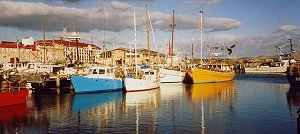
Hobart
March
North-western Tasmania
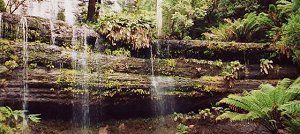
A waterfall in Mount Field National Park
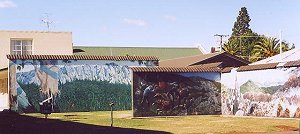
Sheffield, Tasmania's "town of murals"
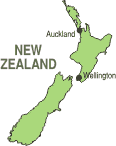
Wellington
Rotorua
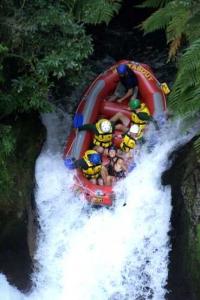
On the brink of a seven-metre waterfall
Auckland
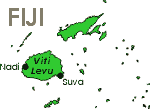
Nadi
The Viti Levu Highlands
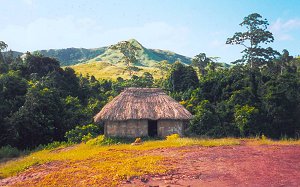
In the highlands of Viti Levu, Fiji
Suva
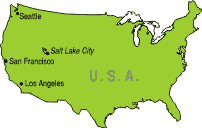
Los Angeles
San Diego
Tijuana
Phoenix
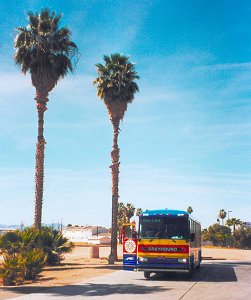
A Greyhound bus making a rest stop in outback California
Las Vegas
Salt Lake City
San Francisco
April
Seattle
Banff
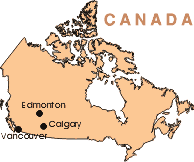 I decided to wait until next week to explore Vancouver, and instead got a bus eastwards into the Rocky Mountains, along the famous Trans-Canadian Highway. I got off the bus in Banff, Alberta, a small mountain town about a mile above sea level. The journey there from Vancouver lasted fourteen hours but the scenery along the way was amazing - snow-covered peaks, icicle-draped cliffs, majestic forests, and huge elk by the roadside.
I decided to wait until next week to explore Vancouver, and instead got a bus eastwards into the Rocky Mountains, along the famous Trans-Canadian Highway. I got off the bus in Banff, Alberta, a small mountain town about a mile above sea level. The journey there from Vancouver lasted fourteen hours but the scenery along the way was amazing - snow-covered peaks, icicle-draped cliffs, majestic forests, and huge elk by the roadside.
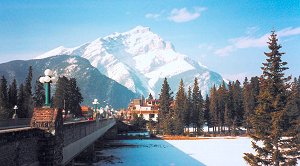
Banff, AlbertaCalgary
Edmonton
Vancouver
Epilogue
|
"There's salt and spray on the beaches of the island that I came from from a song by Scottish band Runrig |
